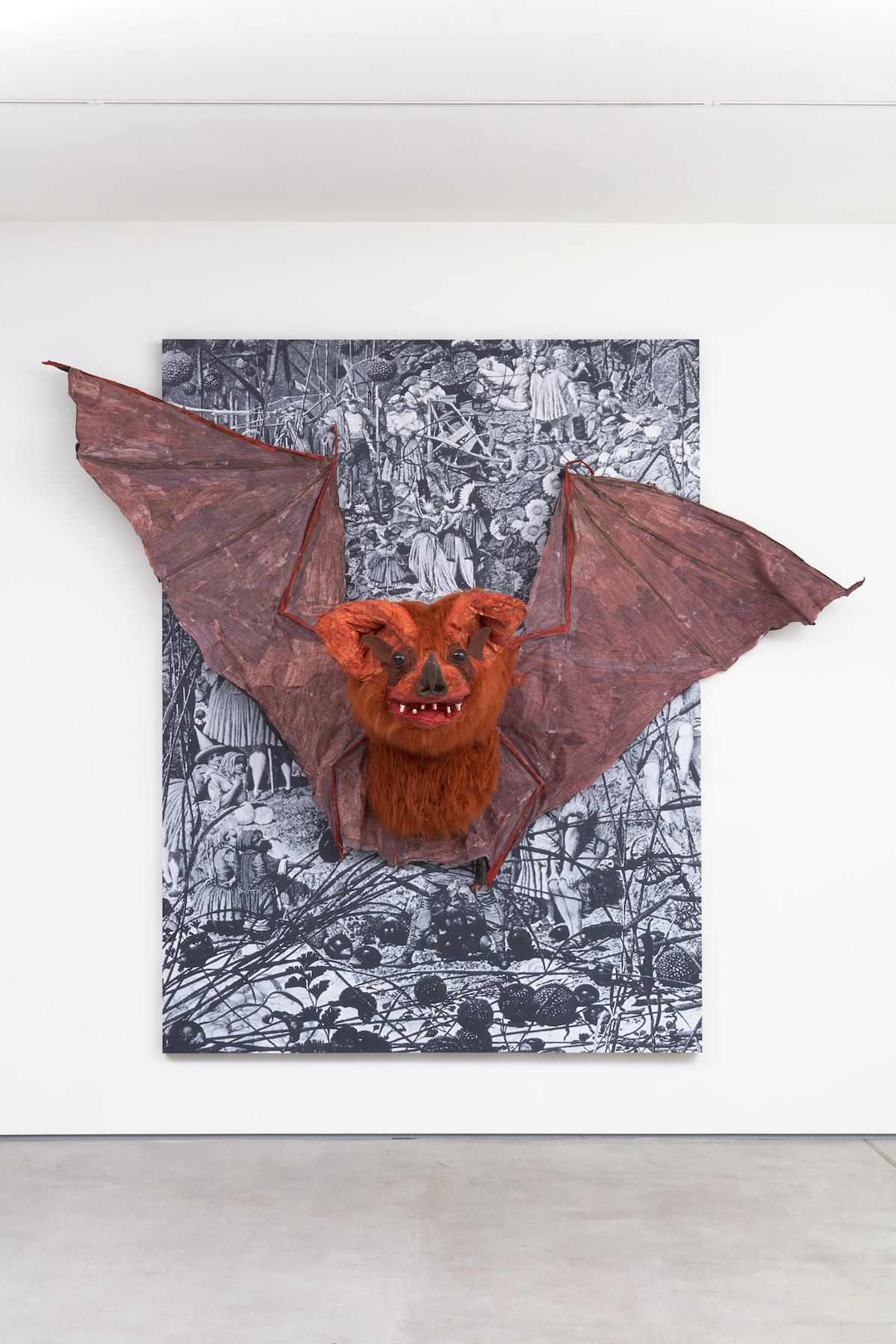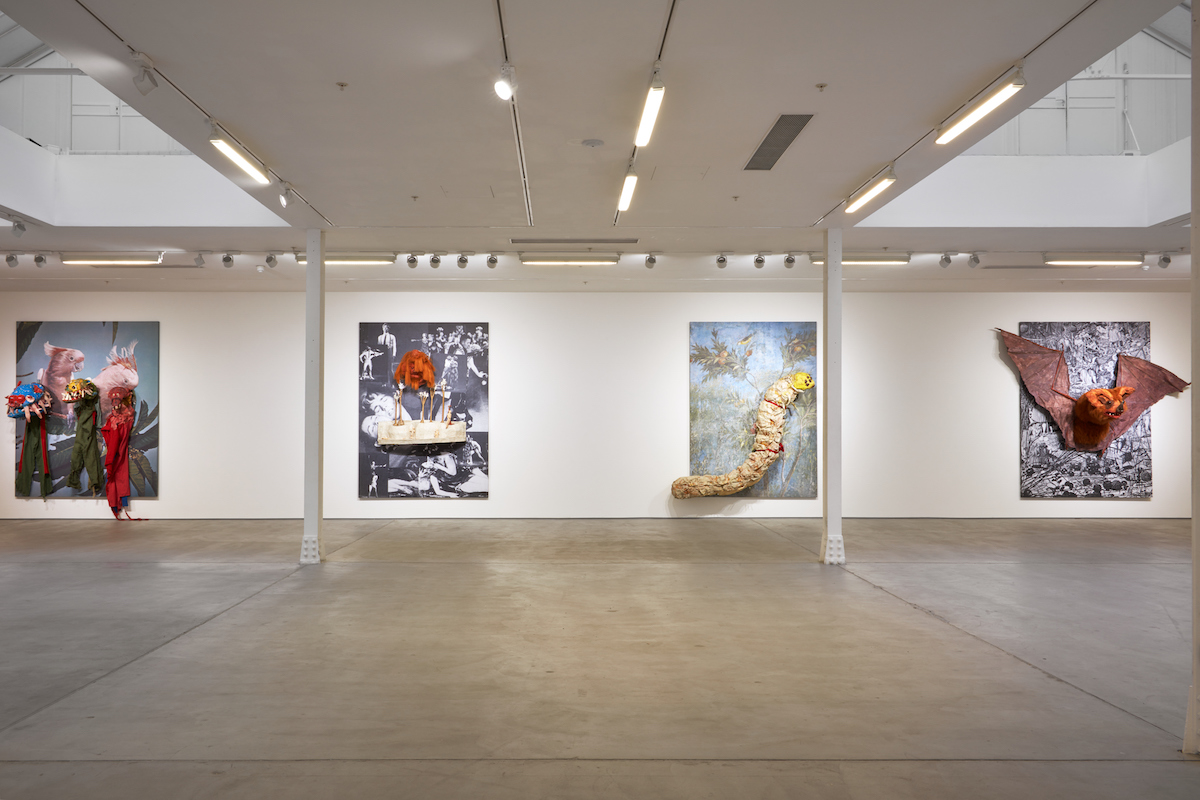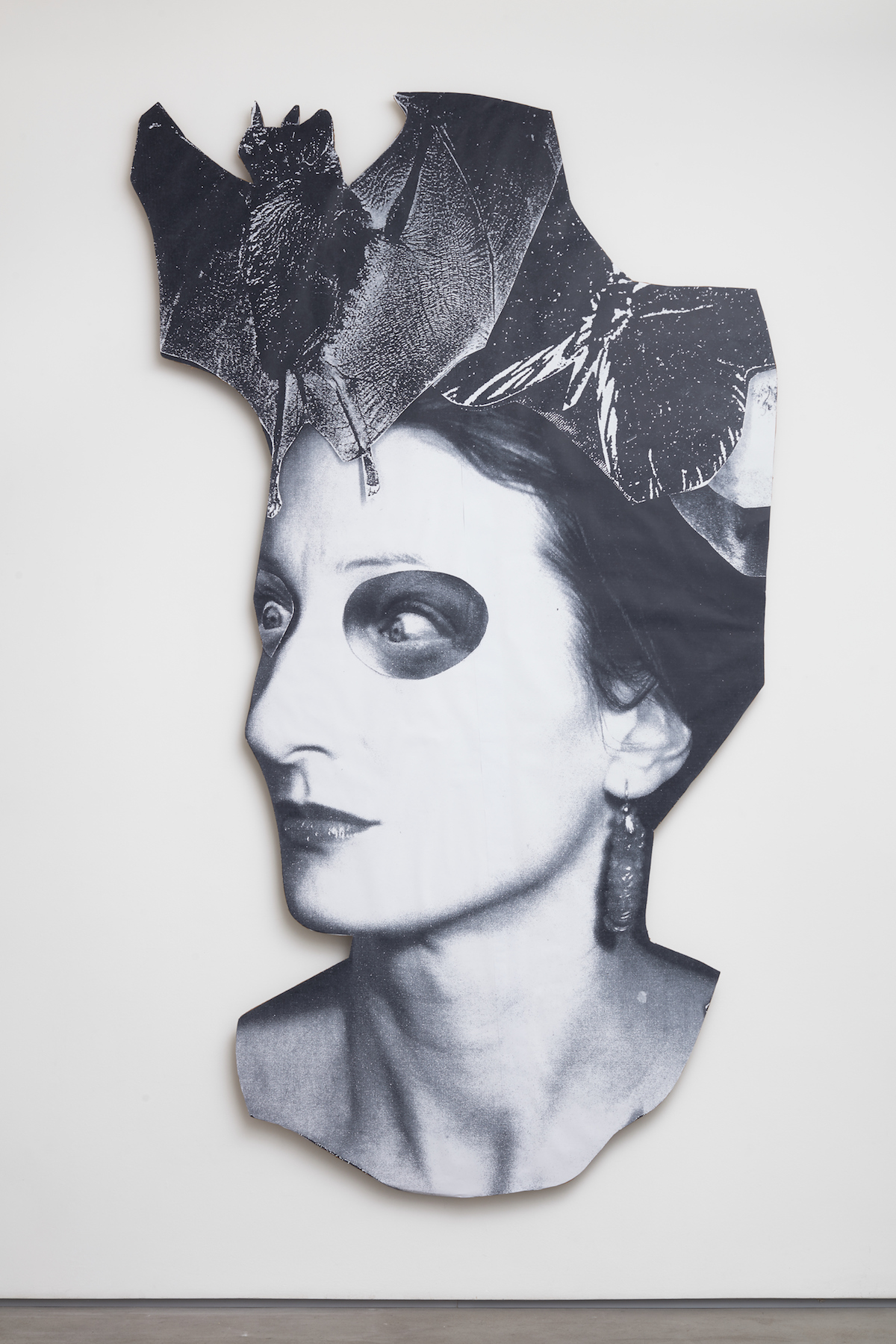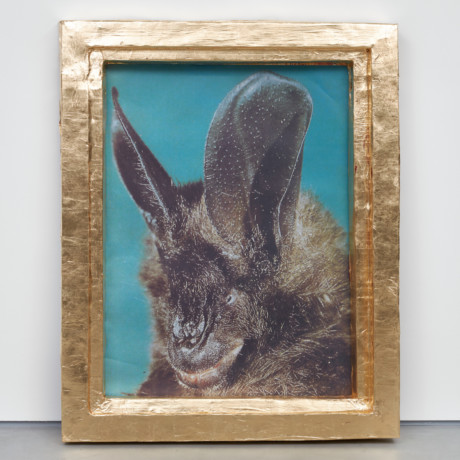
Marvin Gaye Chetwynd first made her name with fabulously exuberant parties hosted in her flat, from naked soirées to surrealist dress-ups. Her handmade costumes and props, built from papier-mâché, latex and cardboard, and a love of popular culture, have shaped a practice that has seen her and her collaborators exhibit everywhere from Art Basel to the Tate. Nominated for the Turner Prize in 2012, her early performances have expanded to incorporate painting, film and sculpture, collapsing the distinction between them to assert a voice that is totally her own.
In Ze & Per, her latest exhibition at Sadie Coles, a new series of paintings condense the cacophony of her performances and installations into wall-mounted pieces that burst forth from all sides of the gallery. It raises questions around high and low art, asking what distinguishes a prop from a painting. Exaggerated gold frames wryly press the point, projecting a fantasy that is as deliberately naive as it is bitingly playful. The politics of Chetwynd’s work are easy to miss amidst the parties and papier-mâché, but there is a seriousness to her experimentation that continues to push the boundaries of acceptability. Here, she discusses her unique outlook.
On the power of a good party…
My work comes very simply from parties and wanting to have fun. As a kid I didn’t have many birthday parties; when I turned eighteen, I understood that as an adult you could correct the things you hadn’t had. So I was very sincere about organising parties where people felt really bonded. I was aware that in life, even at that age, you suffer from this weird insecurity of people endlessly asking what you did, or where you lived: this pigeon-holing with things that people can be insecure about. I worked out really quickly that if you had a fancy dress party, people would be distracted: you would be talking about the costume. Everyone was at ease.
It was at the same time that I was studying anthropology, so it was about various concepts from social anthropology. They’re not heavy, but you could mix cultural rituals and different ideas of gender into your own blend. I was doing these quite light-hearted events in my flat with things like The Futurist Cookbook and other source material. The parties were amazing! It really was successful, so it enabled me to gain confidence because it was something that I was doing well. I understood that it was natural to me. I would do a party every few months because it was something that I really needed in my life. I would plan one, and then I would get on with everything else like my Saturday job and studying, but I would still have my mind set on the next one.

On when silliness becomes serious…
The parties were always inspired by something I was annoyed by, some advert… like the old Ferrero Rocher ads with the pyramids of chocolates and this schmooziness. Silly things that you’d never think of as serious or political, but what happened over years and years of doing it, and then being at art college, is it started crossing over and people started taking it seriously. I realised there was something important here, and that I shouldn’t stop the parties. I found more momentum and became more motivated. They have developed since, they were more innocent and had less of an agenda—they were just gestural. Now, I would say that I am quite serious about them, because I’ve had to become serious in order to protect them. Now, I understand what people were talking about when they said they were political, whereas before I would just shrug it off and go, “What are they talking about? They’re just parties.” But I totally get it now.
I really love this documentary and interview with Frank Zappa called Eat That Question, which came out last year. It was so brilliant to understand how serious and brilliant and sober and hardworking he was about managing to continue to be experimental. I have a similar attitude: I am one-thousand-percent serious about it. I’m very good at understanding when I’m beginning to be trapped or when I’m getting pushed, and I know how to be fluid. Comedy is so important. I think that Britain has amazing comedy, it’s incredible. I have a huge respect for that. Also, I know it sounds silly to mention it, but with things like The Simpsons, the level of layering and cleverness and satire, it’s just remarkable.
“The handmade links, for me, to punk or DIY culture, where you can truly be autonomous and have a voice”
On why all type of venues should be embraced, from museums to nightclubs…
I used to wonder, if I was offered the opportunity to do a performance or something in the Tate, should I say no? Should I always try to keep to nightclubs and my domestic space? It was an important breakthrough for me when I realised that I should think of everywhere as equal, as if it’s part of the earth and the building is impermanent. You take the building away, and it’s just a piece of ground. Why don’t I have the right to do whatever I want there? Nothing to be intimidated by, no rules to be listened to. Just use things and take things that can work for you. I realised not to worry about whether I should behave differently in a commercial space, a museum or elsewhere. It’s really important to me that I don’t.
They all have different things to negotiate; for example, there aren’t many health and safety regulations in commercial galleries, while institutions are heavily regulated with rules on things like nudity—there is lots of control. Of course, it’s easy in your own domestic space. I bridge these a lot. I have to do things that are totally unexposed, like in your house or in a park, but then I seem to be driven to represent in higher echelons too because I believe that there is no reason not to have that exposure. You just have to cope, and not do too many of them. I find museum shows very draining, but you learn a lot from them. It’s good because it helps to understand how to communicate to different groups of people who you never would otherwise, but on another level I would probably be very disillusioned if I didn’t get time to do projects that were answering only to myself.

On the importance of collaborating with friends and family…
Whenever I’ve got an idea about a subject matter that I’m excited by, I will talk to a friend or anyone around me, and it’s very important to hear their thoughts on whether it’s interesting, which influences the direction I take it in. After that I’ll start making, which takes a lot of motivation and self-discipline. This time in the studio is hard work, and there’s a level where I run out of steam, and get disillusioned and exhausted. It’s when you unite the costumes with the people that it gets really exciting; it’s the contribution of the person who will put it on in a different way. The whole interaction is crucial. I definitely couldn’t do it without them, but I’m the one who is initiating the idea and checking all the time. I’m asking what they think. Do they like it? Is the idea right? Is this the right angle?
On a more personal level, quite often I will do almost like a variety show, where the person is actually invited in their own right. I did a Helmut Newton’s Ladies Night, where anyone could come and perform their own thing: you are doing it, and this is you. I do those kinds of events, but it’s a different kind of performance when it’s in my name and about a specific subject matter, which people come and volunteer for. We all sort of hand ourselves over to it. They also of course contribute, bringing their own ideas, and it’s fun and it’s like a game; like we’re all playing together.

On snobbery in the art world…
My mum is in the film industry, she’s an Oscar-winning production designer, so I was brought up as a child on set making props. When I was doing my MA in Fine Art at the Royal College of Art, I was actually employed to make paintings for my mum’s film Surviving Picasso. I was doing Matisse paintings in the same studio as trying to do my own paintings for college. My tutors couldn’t understand how I would separate making a prop, a painting of a Matisse to be in a film, from my own work. For me it was the simplest thing in the world but they actually couldn’t comprehend it, so then they started to say that I didn’t even make paintings. They were insulting me. I remember being a little bit unaffected by it, and not fully understanding. And then, right at the very end, when I made these bat paintings, they turned around to give me the compliment that I had finally made a painting.
On the empowering honesty of the DIY aesthetic…
When I was at art college, I was asked whether what I did was a reaction to films like The Matrix, and the more CGI-heavy filmmaking, but if it is then it’s unconscious. It’s more to do with the DIY, when something is honest and when you look at it you can see how it’s made. One of my favourite films is The Dark Crystal by Jim Henson. The making-of is incredible because it basically took five years to make. It’s so enjoyable. One person sculpts the eyes of a puppet while another does the head. It’s so overly involved and intricate and indulgent. It’s so good. It’s an honesty of materials, compared to all the tricks and slickness that I find intimidating. It’s important to me to make people feel empowered, as if you could do it yourself and join in, and you can see exactly how it was made. All those signifiers are really crucial, and the things I do are a mixture.
The handmade links, for me, to punk or DIY culture, where you can truly be autonomous and have a voice, and then there’s also a sophistication that comes with a commitment to subject matter. There’s a lot of discussion to my work, and the glue of the project will be that discussion and shared understanding, and then the absurd element is that perhaps instead of writing a manifesto or a radio play, we actually do a mime. It’s not a normal way of responding to a strong emotion on injustice or wanting to rehabilitate a figure in history. To stand up and do a mime sounds absurd, as if you’re not going to get anywhere with it. But, for some reason, it’s built momentum over years and years, and it’s been amazing.
All images copyright Marvin Gaye Chetwynd, courtesy Sadie Coles HQ, London






